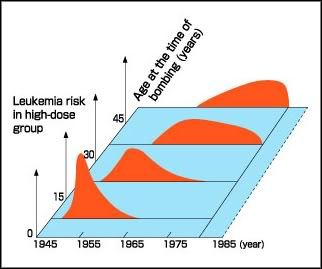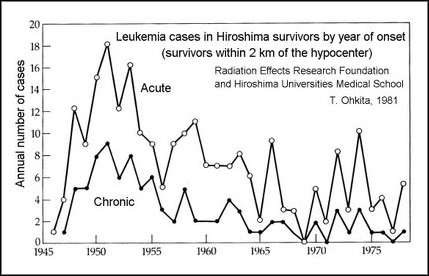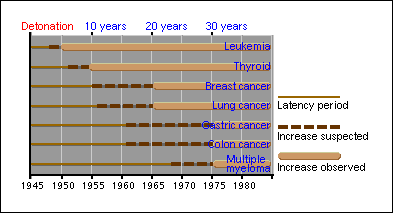Human effects of atomic explosion – video 1
VIDEO: Human burns from the dropping of the atomic bomb (HUMAN)

Still from the video: Burns on woman’s back. Severely burned but still alive.
Human effects – video 2
VIDEO: People suffered burns in atomic bombing (HUMAN2)
Human effects – video 3
VIDEO: (HUMANS3)
“One of the serious consequences of the thermal radiation from a nuclear explosion is flash burns resulting from the absorption of radiant energy by the skin of exposed individuals.
A distinctive feature of flash burns is their sharp limitations to exposed areas of the skin facing toward the center of the explosion.” AtomicArchive

The mouth of a man who has suffered a 10 to 20 Gy dose 21 days after the exposure, note that damage to normal skin, the lips and the tongue can be seen
http://www.answers.com/topic/radiation-poisoning?cat=health
Nagasaki Atomic Bomb Museum
Damage Caused by the Flash of Heat
The heat generated over a short span of a few seconds showered down on unshielded people and caused terrible burns. In particularly severe cases, the skin came off in sheets, revealing the subcutaneous tissues and bones. The burns were fatal within a distance of 1.2 kilometers. In the area near the hypo-center, meanwhile, the heat instantly carbonized human bodies and vaporized their internal fluids.

Work clothing and cap
A worker was wearing this outfit when exposed to the atomic bombing at Mitsubishi Nagasaki Steel Works, about 1.2 kilometers from the hypo-center. The parts exposed directly to the heat rays are scorched black.
http://www1.city.nagasaki.nagasaki.jp/na-bomb/museum/m2-5e.html

Helmet with the remains of a skull
Part of the victim’s skull remains on the inner surface of this helmet found near the hypocenter.
http://www1.city.nagasaki.nagasaki.jp/na-bomb/museum/m2-5e.html
Human Injuries Caused by Radiation
The radiation released by the explosion of the atomic bomb penetrated human bodies and destroyed cells in various tissues. The extent of injuries depends on the radiation dose, but the vast majority of all people within a distance of one kilometer from the hypocenter died. Since this includes people without external injuries, it shows the destructive capacity of radiation. The damages caused by the atomic bomb did not end at the moment of the explosion. The radiation wreaked deep internal injuries that appeared in subsequent years in various symptoms.

Marked splenomegaly
(swollen spleen):4,000g.
(chronic myeloid leukemia)
A normal spleen of the same
age is shown on the right: 110g
http://www1.city.nagasaki.nagasaki.jp/na-bomb/museum/m2-8e.html
Black Rain
After the explosion, a huge mushroom-shaped cloud towered over Hiroshima. Twenty or thirty minutes later, it was picked up by a westward wind and drifted northeast, its shape gradually crumbling. The cloud rained black rain on the areas it passed over. The rain contained mud and dust stirred up by the explosion, soot from the fires, and radioactive materials. This black rain exposed even persons far from the hypocenter to radiation injury.
[http://www.pcf.city.hiroshima.jp/kids/KPSH_E/hiroshima_e/sadako_e/subcontents_e/08higai_4_e.html]

Approximately twenty to thirty minutes after the explosion, rain began falling in northwestern areas of the city. The rain fell in huge black raindrops for an hour or two, then turned to normal rain that continued into the evening. The rain covered an area about 29 kilometers long and about 15 kilometers wide.
http://www.pcf.city.hiroshima.jp/virtual/cgi-bin/museum.cgi?no=4012&l=e
A person whose eyeballs were popped out by negative pressure (500 meters from the hypocenter)
August 10, 1945
The momentary drop in air pressure after the powerful blast burst people’s eyeballs and internal organs out of their bodies.
http://www.pcf.city.hiroshima.jp/kids/KPSH_E/hiroshima_e/sadako_e/subcontents_e/08higai_3_e.html
Blast pressure and negative pressure

http://www.pcf.city.hiroshima.jp/virtual/cgi-bin/museum.cgi?no=2009b&l=e
Negative pressure video
VIDEO: Negative pressure in A-bomb blast
Dailymotion | Hiroshima Peace Site
Glass removed from people’s bodies
The powerful blast splintered glass into tiny fragments that pierced people’s bodies. Even now some survivors have glass embedded in their bodies.


Glass fragments removed from bodies
http://www.pcf.city.hiroshima.jp/kids/KPSH_E/hiroshima_e/sadako_e/subcontents_e/08higai_3_e.html
______________________________________________________
Damage from the Heat Ray
The temperature at the center of the fireball generated by the atomic bomb at the moment of detonation was more than 1 million degrees Celsius. One second later, the fireball had grown to its maximum diameter of 280 meters. The fierce heat ray emitted from that fireball raised surface temperatures at the hypocenter to 3,000°C to 4000°C. (The surface temperature of the sun is 5,700°C; iron melts at 1500°C.)
http://www.pcf.city.hiroshima.jp/kids/KPSH_E/hiroshima_e/sadako_e/subcontents_e/08higai_2_e.html
A Schoolgirl with Burns
August 10, 1945
Those exposed to the ferocious heat ray sustained serious burns. Skin exposed directly to the heat ray (with nothing to shield it) within roughly 1.2 kilometers of the hypocenter was burned to black char. Even internal organs were affected. Virtually everyone burned in this way died immediately or within a few days.

IMG: Badly burned in the face from the thermal energy that radiated from the blast. Note the other parts of the body which are not affected. However, the woman is still alive. http://www.pcf.city.hiroshima.jp/kids/KPSH_E/hiroshima_e/sadako_e/subcontents_e/08higai_2_e.html
A man burned by the heat ray except where his waistband covered him
August 7, 1945
This man exposed within a kilometer of the hypocenter was critically burned over his whole body except where his waistband covered him.

IMG: The man in the picture above is badly burned but still clinging onto life and is receiving medical care. Note the band of unaffected skin. This is where the man wore a belt. The belt protected him from the thermal energy. URL: http://www.pcf.city.hiroshima.jp/kids/KPSH_E/hiroshima_e/sadako_e/subcontents_e/08higai_2_e.html
——————-


For the man-in-the-open example above, that’s 2.2 miles from the detonation of a 500 KT air burst where the shock wave would arrive about 8 seconds after the detonation flash, this sharp body slap would produce a 10-psi overpressure over his body that might perforate his eardrums. Additionally, though, he would experience a blast of wind of about 295 mph for about three seconds that would launch him careening into a probably fatal impact and he would also likely suffer injuries from flying missile fragments of glass and debris.
http://www.radshelters4u.com/#100
Radiation dose and symptoms

The symptoms that appear after full-body exposure to radiation vary with the dose received. A dose greater than 7,000 millisieverts is nearly 100% lethal.
http://www.pcf.city.hiroshima.jp/virtual/cgi-bin/museum.cgi?no=4017&l=e
Body Parts Most Vulnerable to Radiation

The effects of radiation differ with the type of radiation and the parts of the body exposed. Radiation is especially harmful to the blood-forming bone marrow, the mucous membranes in the intestines, the genital organs, and other tissues in which cells divide rapidly.
http://www.pcf.city.hiroshima.jp/virtual/cgi-bin/museum.cgi?no=4018&l=e
Keloids (radiation effect)
Beginning in early 1946, scar tissue covering apparently healed burns began to swell and grow abnormally into mounds of thick, twisted flesh called keloids. Keloids occured in 50 to 60% of people who suffered burns directly from the heat ray within a radius of 2 kilometers from the hypocenter.These keloids were a source of great physical and emotional pain for the survivors.
http://www.pcf.city.hiroshima.jp/peacesite/English/Stage1/1-5/1-5-6E.html
November 13, 1945, Photo by US Army
Keloids appeared on her face, back, and the joints of her arms and legs. Keloids hindered the movement of joints and caused tremendous physical and psychological suffering.

After a burn, skin regenerates to cover and heal the injury, and this process usually leaves a scar. The term “keloid” refers to an irregular mass of abnormal scar tissue that reproduces excessively.
http://www.pcf.city.hiroshima.jp/virtual/cgi-bin/museum.cgi?no=4023&l=e
A-bomb cataracts
Taken in April 1966
Courtesy of the Department of Ophthalmology, Faculty of Medicine, Hiroshima University
The patient was exposed 820m from the hypocenter and had white cloudiness in both eyes. The dark area in the center of this photo is the cloudiness caused by an A-bomb cataract.

Radiation can cause the center posterior part of the lens to become white and cloudy, leading to loss of sight. Cataracts occurred several months to several years after exposure.
http://www.pcf.city.hiroshima.jp/virtual/cgi-bin/museum.cgi?no=4027&l=e
Leukemia
Courtesy of the Research Institute for Radiation Biology and Medicine of Hiroshima University
In the bone marrow in the upper picture, we see various types of young blood cells, including healthy white cells. The marrow below contains only immature leukemic blood cells.

(Courtesy of the Research Institute for Radiation Biology and Medicine of Hiroshima University)
In the bone marrow in the upper picture, we see various types of young blood cells, including healthy white cells. The marrow below contains only immature leukemic blood cells.
Leukemia is cancer of the blood. The white blood cells multiply wildly without fully maturing. Red blood cells and platelets are reduced, leading to anemia. The white blood cells increase in number but lose normal functioning, which lowers resistance to infection. The incidence of leukemia was greatest 7 to 8 years after the bombing. The younger the survivor was at the time of exposure, the earlier was the onset of leukemia.
http://www.pcf.city.hiroshima.jp/virtual/cgi-bin/museum.cgi?no=4028&l=e
Bone marrow displaying acute leukemia

Provided by the Hiroshima Red Cross and Atomic-bomb Survivors Hospital
1,700m from the hypocenter
Hiratsuka-cho
A 9-year-old girl exposed in a wooden house received no burns or other injuries. She grew up strong and healthy. In June 1959, about fourteen years after the bombing, she suddenly experienced fatigue, dizziness, bleeding from gums, and other symptoms. Her symptoms persisted, and she was hospitalized. In late June the following year, her legs began swelling without subsiding, eventually to the point of bleeding. She died in late July.
http://www.pcf.city.hiroshima.jp/virtual/cgi-bin/museum.cgi?no=4029&l=e
Age of onset of leukemia
The incidence of leukemia among A-bomb survivors was found to be in proportion to the doses of radiation to which they were exposed. Furthermore, the younger they were when exposed, the higher the leukemia risk. The peak of leukemia onset was about 7 to 8 years after exposure

Source: Effects of A-bomb Radiation on the Human Body 1992,
Ed. Hiroshima International Council for Medical Care of the Radiation-exposed, Bunkodo
http://www.pcf.city.hiroshima.jp/peacesite/English/Stage1/1-5/1-5-6E.html

The younger the person is at the time of exposure, the sooner leukemia develops.
Note)”High-dose” means 1 Sievert or more. Reference: A-bomb Radiation Effects Digest 1992
http://www.pcf.city.hiroshima.jp/virtual/cgi-bin/e/Leukemia_e.htm
Graph of leukemia cases in Hiroshima

http://glasstone.blogspot.com/2007/03/above-3.html
Graph of cancer and leukemia mortality in Hiroshima-Nagasaki

http://glasstone.blogspot.com/2007/03/above-3.html
Injuries from Glass
The blast also threw people across distances of several meters. Others were crushed inside their collapsed houses.
Countless shards of glass penetrated the victims’ bodies. Even today, fragments of glass are discovered and removed from atomic bomb survivors who complain of bodily pains.
http://www.pcf.city.hiroshima.jp/virtual/cgi-bin/museum.cgi?no=2001&l=e
Glass Fragment Expelled Naturally

Donated by Norio Nakabayashi
1,100m from the hypocenter
Norio Nakabayashi (then, 17) was exposed to the bomb in the auditorium of Hirose Elementary School where he was stationed. He managed to escape from the collapsed building, but window fragments pierced his back and neck in about 120 places. He returned to his partially destroyed house in Eba on August 9, where he was confined to his bed for three months. This fragment emerged naturally from a swelling on his left cheek about 29 years after the bombing.
http://www.pcf.city.hiroshima.jp/virtual/cgi-bin/museum.cgi?no=2002b&l=e
Surgically removed glass fragment

Donated by Chiyoko Kosaka
1,000m from the hypocenter
Teppo-cho(now Kaminobori-machi)
Chiyoko Kosaka (then, 12), a first-year student at Hiroshima Jogakuin Girls High School, was exposed to the bomb in her house in Teppo-cho, 1,000 meters from the hypocenter. Glass fragments penetrated deep into her entire body, and she was trapped under the collapsed house. She was saved by her parents, who were both at home when the bomb exploded. Her brother Shoji (then, 11) was exposed near their home. He was fleeing and looking for his family with his sister Noriko (then, 3) on his back. They accidentally ran into their father Kaneyoshi, but Noriko died later that day and Shoji died the next day. Chiyoko got purple spots all over her body, lost her hair and suffered other effects of acute radiation poisoning, but she managed to survive. This glass fragment was surgically removed in August 1965, twenty years after the bombing.
http://www.pcf.city.hiroshima.jp/virtual/cgi-bin/museum.cgi?no=2003&l=e
Malignant tumors
Beginning around 1960, the incidence of cancer began to increase. The main cancers included thyroid, breast, lung, and salivary gland. The role of radiation in cancer is profoundly significant. Some researchers have reported a direct correspondence between distance from hypocenter, probable exposure dose, and malignancy rates.

Source: Effects of A-bomb Radiation on the Human Body 1992,
Ed. Hiroshima International Council for Medical Care of the Radiation-exposed, Bunkodo
http://www.pcf.city.hiroshima.jp/peacesite/English/Stage1/1-5/1-5-6E.html
Breakdown of Energy Released

http://www.pcf.city.hiroshima.jp/peacesite/English/Stage1/1-4/1-4-4E.html
Damage due to heat rays
At the instant of detonation, an enormous fireball was created in the air which, within 1 sec of detonation, had grown to its maximum diameter of 280 meters. Temperatures on the ground reached 5,000°C.
The powerful heat rays burned exposed human skin up to 3.5 km from the hypocenter. Anyone within 1.2 kilometers who was directly exposed received deep burns not just to the skin but deep into the tissues and internal organs. Nearly all died instantly or within a few days.
The temperature on the ground reached 2,000 °C as far as 600 meters from the hypocenter. Roof tiles within this radius displayed the unique marks of a surface that had melted and bubbled. Even far from the hypocenter dark letters or patterns on clothing or paper were instantly burned out. Here and there, railway fences ignited and burned

A man burned over his entire body; exposed within 1 km of the hypocenter;
August 7, 1945 / Photo by Masami Onuka. But he still survives.

Another survivor. A man burned over
August 7, 1945 / Photo by Masami Onuka
http://www.pcf.city.hiroshima.jp/peacesite/English/Stage1/1-5/1-5-2E.html
Thermal Radiation Heat Burns (Nagasaki)

A boy was exposed to thermal rays about 1.5 miles from the hypocenter. February 1946.
Photo: the U.S. Army. [Photo of Sumiteru Taniguchi’s back injuries from the U.S. atomic bomb attack on Japan, taken in January 1946. Sumiteru is still alive, but every day continues to suffer from extremely painful injuries from the U.S. atomic attack.]
http://www.csi.ad.jp/ABOMB/RETAIN/burns1.html
WRH – Victim lacerated by glass
VIDEO: “911.wtc.glass.blew.out”
“I was standing next to 1 World Trade Center and then all of a sudden I heard rumbling and we all started running away from it. The glass like blew out and threw me onto the sidewalk … and I couldn’t see for like twenty seconds…”
Blast effects – Overpressure

Again, though, as in a tornado, prompt protective actions can make a great difference in ones survivability. For example, it requires about eight times the blast wind force to move a person who is lying down compared to a standing person. Diving into a ditch, depression, basement or anywhere else normally thought of for tornado protection will improve your odds greatly. You are also much less a target for glass shards and debris missiles. This simple change in vulnerability, but of this magnitude, can save many lives.
All buildings will suffer light damage from the shock wave at even 1 psi peak overpressure–shattered windows, doors damaged or blown off hinges and interior partitions cracked. The maximum wind velocity would be only about 35 miles per hour. As the overpressure increases, so does the blast wind–exceeding hurricane velocities above about 2 psi.
http://www.radshelters4u.com/#100
Burn Injuries in the Open

In most places however, besides fog, smog, haze or clouds, there are buildings, trees, hills and other objects that would also block and reduce some portion of the thermal pulse. In fact, the more densely built up an area is then the less likely the inhabitants would be exposed to suffer the full impact of the thermal pulse. Of course, though, they may still have to deal with the resultant fires created by the thermal pulse and from any blast damage.
http://www.radshelters4u.com/#100
Percentages of Population Killed
(as a function of peak overpressure) [name of chart]

Source: NRDC, The US Nuclear Plan: A Time for Change, 2001.
Original source: OTA, The Effects of Nuclear War, 1979.
[Glaser PDF]
Analysis of the WTC dust














http://www.ehponline.org/members/2002/110p703-714lioy/lioy-full.html



